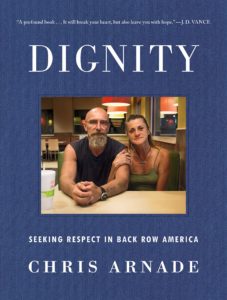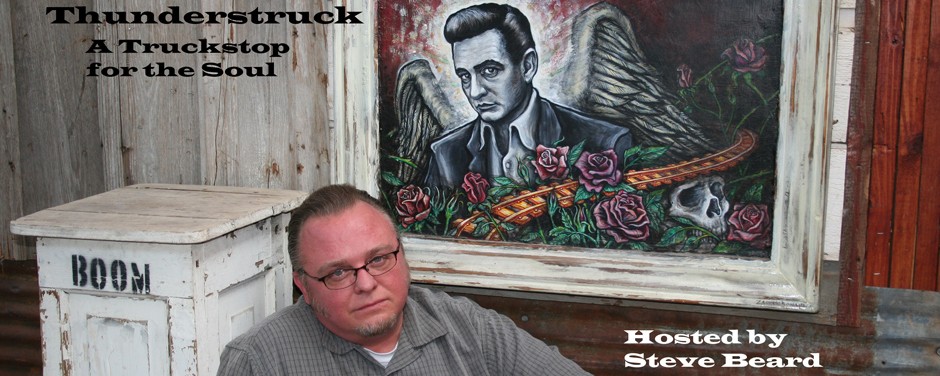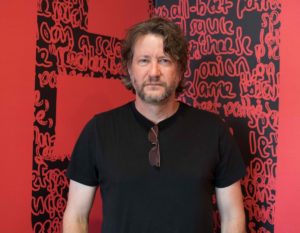Chris Arnade earned a PhD in theoretical physics and spent 20 years on Wall Street making piles of money as a bond trader. In a season of disillusionment with his lucrative career, he began walking around New York City to relieve stress and take photographs of graffiti artists, Schwinn bike clubs, and pigeon keepers. That hobby led him to eventually become an irreplaceable photojournalist and chronicler of the down-and-outers and drug addicted in our ferociously polarized society.
For three years, he went in search of those who “lived under bridges, in abandoned buildings, in sheds, in pits, in broken-down trucks, on rooftops, or, if they scored enough money, in per-hour motels,” he writes in Dignity: Seeking Respect in Back Row America (Sentinel 2019). Traveling more than 150,000 miles to has-been communities struggling to survive, he photographed and interviewed the poor and strung out in places such as Buffalo, New Haven, Cleveland, Selma, El Paso, and Bakersfield. “In each of these places, people have a sense of being left behind and forgotten – or, worse, mocked and stigmatized by the rest of the world as it moves on and up….”
Several years ago, he wrote an article for The Guardian in the U.K. titled, “The people who challenged my atheism most were drug addicts and prostitutes.” That was the first time he told the story of meeting Takeesha as she was washing her face at a trickling fire hydrant in the South Bronx. “She was working, wearing thigh-high faux-leather red boots and leopard-print tights, waving at every car or truck that passed by.” In conversation, he discovered her devastating backstory: Her mother’s pimp put her on the streets at twelve, she had her first child at thirteen, and was addicted to heroin. Arnade asked her the question he asks everyone he photographs: How do you want to be described? She replied without a pause, “As who I am. A prostitute, a mother of six, and a child of God.”
 Sociologically, Arnade views the well-educated and upwardly-mobile (himself and his friends) as the kids who sat on the front row of the classroom, “eager to learn and make sure the teacher knew we were learning…. We valued what we could measure, and that meant material wealth. Things that couldn’t be measured – community, dignity, faith, happiness – were largely ignored because they were hard to see, especially from so far away.”
Sociologically, Arnade views the well-educated and upwardly-mobile (himself and his friends) as the kids who sat on the front row of the classroom, “eager to learn and make sure the teacher knew we were learning…. We valued what we could measure, and that meant material wealth. Things that couldn’t be measured – community, dignity, faith, happiness – were largely ignored because they were hard to see, especially from so far away.”
The subjects of his portraits were from the back row of the class, those who “couldn’t or didn’t want to leave their town or their family to get an education at an elite college, the people who cared more about their faith than about science.” Dignity is a humane and insightful mosaic of their images, dreams, and disappointments. Some of the narrative is gut wrenching. Yet the descriptions of the ravages and bondage of addiction are mixed right in with heartwarming stories of small groups of widows and widowers bonding over morning coffee at McDonald’s.
“Often the only places open, welcoming, and busy in back row neighborhoods were churches or McDonald’s. Often the people using the McDonald’s were the same people using the churches, people who sat for hours reading or studying the Bible at a booth,” writes Arnade.
“When I first went to the Bronx, I expected that the people there, those most affected by the coldness and ruthlessness of the world, would share my atheism. Instead, I found a strong belief in the supernatural, and a faith that manifested in many ways, mostly as a belief in the Bible.
“Everyone I met there who was living homeless or battling an addiction held a deep faith. Street walking is stunningly dangerous work, and everyone has stories of being cut, attacked, and threatened, or stories of others who were killed. Everyone has to deal with the danger. Few work without a mix of heroin, Xanax, or crack. None without faith. ‘You know what kept me through all that? God. Whenever I got into the car, God got into the car with me.’”
Arnade describes the dirty Bibles found in crack houses and the “picture of the Last Supper that moves with a couple living on the streets. Rosaries, crucifixes, and religious icons are worn for protection and good luck. Pages of the Bible are torn out, folded up, and kept in pockets, to be pulled out and fingered nervously, or read over in times of stress, or held during prayers.”
In a world that is confused and terrified about how to deal with junkies, those sticking needles in their arms for a high are still clinging to the hope that the Good Shepherd does not turn his back on lost causes. Mainline seminary professors may not buy into demons and the reality of evil, but Arnade’s circle of drug-addicted friends certainly do. They’ve seen the dark side up close.
While churches of all stripes are currently getting bad press – and rightly so, in some cases – Arnade’s experience of low budget storefront churches is surprisingly redemptive. There are no hip coffee bars, but there are hugs and acceptance – even if your clothes smell like cigarettes and you have liquor on your breath.
“For many back row Americans, the only places that regularly treat them like humans are churches. The churches are everywhere, small churches that have come in and taken over a space and light it up on Sundays and Wednesdays,” Arnade writes. “They walk inside the church, and immediately they meet people who get them. The preachers and congregants inside may preach to them, even judge their past decisions, but they don’t look down on them. They have walked the walk and know the sh*t they are going through, not from a book, not from a movie, not from an article, not from a study, but from their own lives or the lives of their friends. They look like them, and they get them.”
These congregations understand the back row people of America, Arnade believes. “The churches are also the way out of addiction, a way to end the cycle,” he writes. “The few success stories told on the streets are of relatives, friends, or spouses who found God, got with the discipline and order of a church, and moved away: ‘Princess met a decent man who was dedicated to the Scripture. She got straight, got God, and last we heard was on a farm upstate.’ ‘Necee went to her grandmother’s and found God, and she now has her one-year chip.’”
Those testimonies ring true with legitimacy to a front row observer like Arnade. “When I walked into the Bronx I was an atheist. It was something I was sure about. After years of traveling America, I wasn’t so sure….,” he confesses at one point.
“I could no longer ignore the value of faith, not as a scientist, not as a person who claimed to want to learn from others. Yet I still saw it as a utility – something popular because it worked. Still, after attending hundreds of different services I was beginning to realize there was more to it than that. My biases were limiting a deeper understanding: that perhaps religion was right, or at least as right as anything could be. Getting there required a level of intellectual humility that I was not sure I had.”
Reading Arnade’s book in search of a big conversion story or a fix-it program with a magic wand will be disappointing. He simply wants to give the displaced, addicted, and marginalized their moment to express their dreams for life – a sliver of dignity – and give us the chance to hear from our back row neighbors.
“On the streets, few can delude themselves into thinking they have it under control. … It is easier to see that everyone is a sinner, everyone is fallible, and everyone is mortal,” he writes. “It is easier to see that there are things just too deep, too important, or too great for us to know. It is far easier to recognize that one must come to peace with the idea that we don’t and never will have this under control. It is far easier to see religion not just as useful, but as true.”
Steve Beard is the creator of Thunderstruck.

